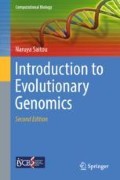Abstract
Characteristics of amino acids, building blocks of proteins, are first discussed, followed by discussions on protein structures and diversity of proteins. Gene family, super gene family, domains, and folds are discussed, and then, major categories of proteins are explained. Finally, history of protein study is discussed.
Access this chapter
Tax calculation will be finalised at checkout
Purchases are for personal use only
References
Devlin, T. M. (Ed.). (1992). Textbook of biochemistry with clinical correlations (3rd ed.). New York: Wiley-Liss.
Patenaude, S. I., et al. (2002). The structural basis for specificity in human ABO(H) blood group biosynthesis. Nature Structural Biology, 9, 685–690.
Dayhoff, M. O., et al. (1965). Atlas of protein sequence and structure. Silver Spring: National Biomedical Research Foundation.
Henikoff, S., & Henikoff, J. (1992). Amino acid substitution matrices from protein blocks. Proceedings of the National Academy of Sciences of the United States of America, 89, 10915–10919.
Koonin, E. V., Wolf, Y. I., & Karev, G. P. (2002). The structure of the protein universe and genome evolution. Nature, 420, 218–223.
Hillier, L., Miller, W., Birney, E., Warren, W., Hardison, R. C., Ponting, C. P., et al. (2004). Sequence and comparative analysis of the chicken genome provide unique perspectives on vertebrate evolution. Nature, 432, 695–716.
Dorit, R. L., Schoenbach, L., & Gilbert, W. (1990). How big is the universe of exons? Science, 250, 1377–1382.
Li, W. H., Gu, Z., Wang, H., & Nekrutenko, A. (2001). Evolutionary analyses of the human genome. Nature, 409, 847–849.
International Human Genome Sequencing Consortium. (2001). Initial sequencing and analysis of the human genome. Nature, 409, 860–921.
Ikeo, K., Takahashi, K., & Gojobori, T. (1992). Evolutionary origin of a Kunitz-type trypsin inhibitor domain inserted in the amyloid beta precursor protein of Alzheimer’s disease. Journal of Molecular Evolution, 34, 536–543.
Long, M., Rosenberg, C., & Gilbert, W. (1995). Intron phase correlations and the evolution of the intron/exon structure of genes. Proceedings of the National Academy of Sciences of the United States of America, 92, 12495–12499.
de Souza, S. J., Long, M., Schoenbach, L., Roy, S. W., & Gilbert, W. (1996). Intron positions correlate with module boundaries in ancient proteins. Proceedings of the National Academy of Sciences USA, 93, 14632–14636.
Vibranovski, M. D., Sakabe, N. J., de Oliveira, R. S., & de Souza, S. J. (2005). Signs of ancient and modern exon-shuffling are correlated to the distribution of ancient and modern domains along proteins. Journal of Molecular Evolution, 61, 341–350.
Patthy, L. (2003). Modular assembly of genes and the evolution of new functions. Genetica, 118, 217–231.
Kawashima, T., Kawashima, S., Tanaka, C., Murai, M., Yoneda, M., Putnam, N. H., et al. (2009). Domain shuffling and the evolution of vertebrates. Genome Research, 19, 1393–1403.
Masuyama, W. (2009). Evolutionary analysis of protein domains in mammals. Ph.D. dissertation, Department of Genetics, School of Life Science, Graduate University for Advanced Studies.
Nakamura, A., Hattori, M., & Sakaki, Y. (1997). A novel gene isolated from human placenta located in Down syndrome critical region on chromosome 21. DNA Research, 4, 321–324.
Saber, M. M., Babarinde, I. A., Hettiarachchi, N., & Saitou, N. (2016). Emergence and evolution of Hominidae-specific coding and noncoding genomic sequences. Genome Biology and Evolution, 8, 2076–2092.
Chou, P. Y., & Fasman, G. D. (1974). Prediction of protein conformation. Biochemistry, 13, 222–245.
Hendriks, W., Mulders, J. W., Bibby, M. A., Slingsby, C., Bloemendal, H., de Jong, W. W., et al. (1988). Duck lens epsilon-crystallin and lactate dehydrogenase B4 are identical: A single-copy gene product with two distinct functions. Proceedings of the National Academy of Sciences USA, 85, 7114–7118.
Mohri, H. (1968). Amino-acid composition of tubulin constituting microtubules of sperm flagella. Nature, 217, 1053–1054.
Keller, B. (1993). Structural cell wall proteins. Plant Physiology, 101, 1127–1130.
Szewczyk, B., Bieńkowska-Szewczyk, K., & Król, E. (2014). Introduction to molecular biology of influenza a viruses. Acta Biochimica Polonica, 61, 397–401.
Simoni, R. D., & Vaughan, M. (2002). The discovery of the amino acid threonine: The work of William C. Rose. Journal of Biological Chemisty, 277, e25.
Sanger, F. (1988). Sequences, sequences, and sequences. Annual Review of Biochemistry, 57, 1–28.
Smithies, O. (1955). Zone electrophoresis in starch gels: Group variations in the serum proteins of normal human adults. Biochemical Journal, 61, 629–641.
Kendrew, J. C., et al. (1958). A three-dimensional model of myoglobin molecule obtained by X-ray analysis. Nature, 181, 662–666.
Berman, H. M., et al. (2002). The Protein Data Bank at 40: Reflecting on the past to prepare for the future. Structure, 20, 391–396.
Saitou, N. (2007). Introduction to evolutionary genomics (in Japanese). Tokyo: Kyoritsu Shuppan.
Author information
Authors and Affiliations
Corresponding author
Rights and permissions
Copyright information
© 2018 Springer Nature Switzerland AG
About this chapter
Cite this chapter
Saitou, N. (2018). Proteins. In: Introduction to Evolutionary Genomics. Computational Biology, vol 17. Springer, Cham. https://doi.org/10.1007/978-3-319-92642-1_2
Download citation
DOI: https://doi.org/10.1007/978-3-319-92642-1_2
Published:
Publisher Name: Springer, Cham
Print ISBN: 978-3-319-92641-4
Online ISBN: 978-3-319-92642-1
eBook Packages: Computer ScienceComputer Science (R0)

